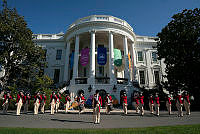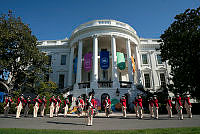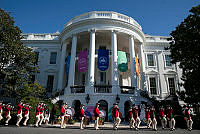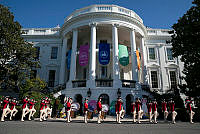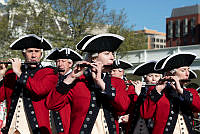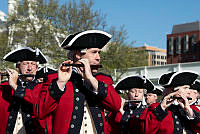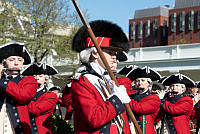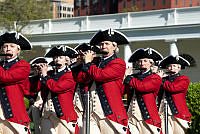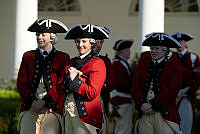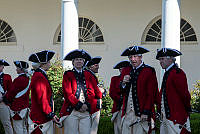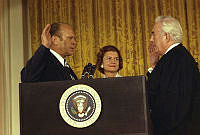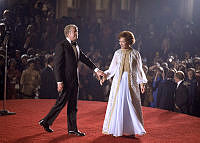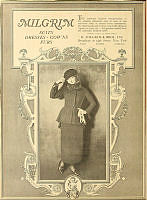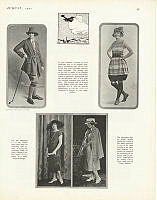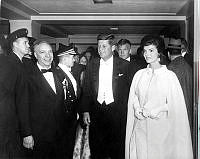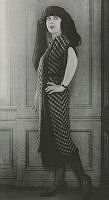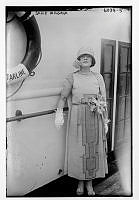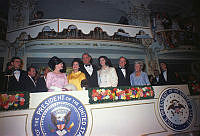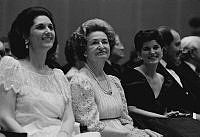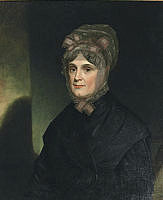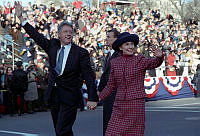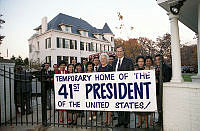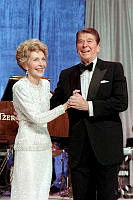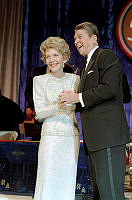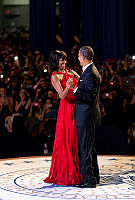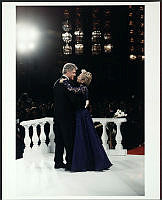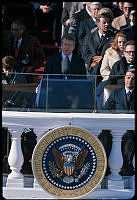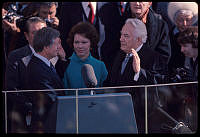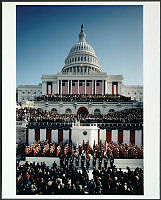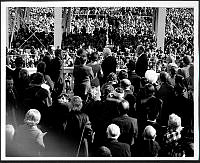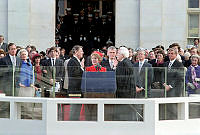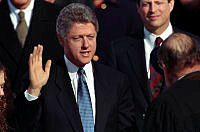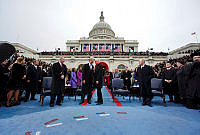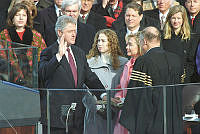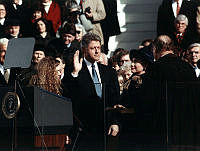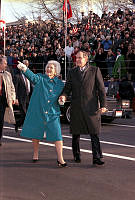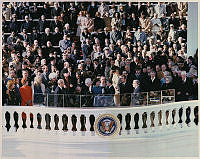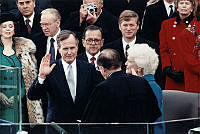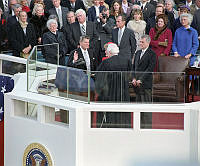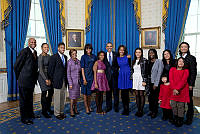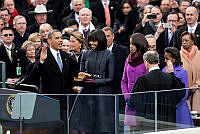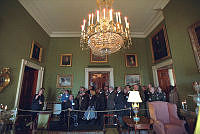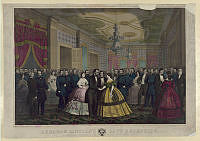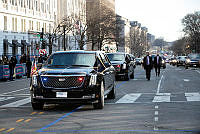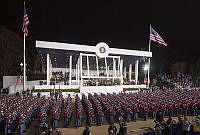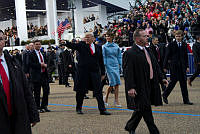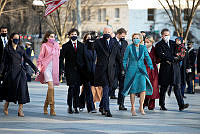Motor Cars Come to the White House
Copyright © Fall 2010 White House Historical Association. All rights reserved under international copyright conventions. No part of this article may be reproduced or utilized in any form or by any means, electronic or mechanical, including photocopying, recording, or by any information storage and retrieval system, without permission in writing from the publisher. Requests for reprint permissions should be addressed to books@whha.org
At the beginning of the twentieth century, some people believed that the automobile was a toy for the rich that would just create a greater class divide in America.1 Others, like President Theodore Roosevelt, remained loyal to the horse. But democracy soon won out. Henry Ford’s introduction of the Model T in 1908 revolutionized American society by creating an automobile affordable for the masses. To honor incoming president William Howard Taft, an automobile enthusiast, in 1909 Congress appropriated $12,000 for the purchase of the first two White House motor cars despite heated protests. Democratic Representative Thetus Sims of Tennessee, for example, proclaimed the motor car was “a dangerous means of travel, not only for the people who ride in it but for the pedestrians. The automobile is a genuine, all around nuisance. . . . I am opposed to this Congress going on record favoring automobiles as a means of travel.”2
Gallery
-

A chauffeur poses in the Pierce Arrow just outside of the White House garage in 1909.
Library of Congress -

A chauffeur poses in the White Motor Company Model M just outside of the White House garage in 1909.
Library of Congress -

President William Howard Taft’s daughter Helen returns to the Pierce Arrow landaulet after a shopping trip on F Street in Northwest Washington, D.C., in 1909.
Library of Congress -

Alice Roosevelt Longworth seated in the Taft Pierce Arrow landaulet in 1912. The chauffeur is Abe Long. The figure not facing the camera is likely President Theodore Roosevelt.
Library of Congress -

President William Howard Taft in the White House Pierce Arrow 66 A. P. Touring Car in 1912. This photograph was probably taken while the president was in Boston to address the Republican Club of Beverly, Massachusetts.
Library of Congress -

1912 model Baker Electric Special Victoria. This two-person automobile was used by First Lady Helen Herron Taft and four other first ladies. It is now in the collection of the Henry Ford Museum, Dearborn, Michigan.
Collection of the Henry Ford Museum
Both newspapers and automobile club publications closely followed the new mode of presidential transportation. In 1909 the Washington Post published a feature on the subject, revealing that the huge steampowered car Taft’s chauffeur George Robinson drove was bought in the president’s native Ohio. The White Motor Company, a branch of the White Sewing Machine Company of Cleveland, provided for the chief of state its Model M, a seven-passenger, 40 horsepower touring car. “The United States coat of arms is artistically painted on each of the doors and the color scheme is a harmonious blend of subdued greens.” For First Lady Helen Herron Taft the government purchased a Pierce Arrow, manufactured in Buffalo, New York. Driven by Abe Long, another White House chauffeur, it was described as a “six cylinder 48 horsepower suburban car, the main color of which is blue, with the door panels a rich russet and a single narrow stripe of the same color following the lines of the molding. . . . Naturally a facsimile of the great seal of the United States is emblazoned on the doors of the car.”3
In 1910 Taft became the first president to attend an auto show, this one held in Washington, D.C. He enjoyed the exhibits and praised the automobile industry for “making greater progress . . . than in any other mechanical art during the last fifteen years.”4 On May 6, 1910, a group of motorists from Richmond, Virginia, participating in the Washington Post Endurance Run, came to the White House on their way to Harrisburg, Pennsylvania. Cross-country motoring was an early and adventurous hobby, and sponsored journeys tested the endurance of the automobile and driver as well as publicizing the rough road conditions. President Taft, sympathetic to the cause, noted: “I am a motorist myself and know what it means to travel over rough roads.”5
The automobile industry had gained a dream spokesman the president of the United States. President Taft’s endorsement of the motor car as the official means of presidential transport created tremendous momentum for the automobile industry and accelerated the movement for improved roads.6 In 1911, the American Association of Highway Improvement supported by agriculturalists, businessmen, highway officials, automobilists, and auto manufacturers convened its first major congress in Richmond, inviting President Taft to be the guest of honor and keynote speaker. Although unable to attend due to a severe cold, the president did send a warm message endorsing their work. He wrote, “The development of good roads is one of the most valuable assets to the country and, of great value to the public.”7
Gallery
-

President Woodrow Wilson’s Pierce Arrow Touring Car, undated photograph.
Library of Congress -

President Woodrow Wilson and First Lady Edith Wilson ride in a parade in downtown Los Angeles while Secret Service agents keep watch. Wilson was on tour promoting the League of Nations, September 21, 1919.
Library of Congress -

President Woodrow Wilson and First Lady Edith Wilson go for a drive in Washington, D.C., March 20, 1920, after his illness.
Library of Congress -

First Lady Edith Bolling Wilson steps from the Pierce Arrow limousine on H Street in Northwest Washington, D.C., near the intersection of 13th and H Streets with New York Avenue in 1920.
National Archives and Records Administration -

The Wilsons’ Pierce Arrow is now in the collection of the Woodrow Wilson Presidential Library in Staunton, Virginia, and is shown in front of Wilson’s birthplace, The Manse, which the library maintains.
The Woodrow Wilson Presidential Library and Museum/NARA
In his last months in office, President Taft again displayed his support for the automobile industry in an unprecedented and spectacular way. To officially open the 1913 automobile show at the Convention Hall, Washington, D.C., he pressed a button from the White House, igniting 150,000 lights at the hall. Chimes pealed, and a large American flag unfurled in a center of the hall filled with automobiles as the United States Marine Band struck up a patriotic tune.8
In a bow to historical tradition, President-Elect Woodrow Wilson chose an open barouche led by four horses for the 1913 inaugural parade. However, advancement of the motor age continued apace at the White House during Wilson’s tenure in office. By the end of 1913, America had produced 1,258,060 automobiles and the industry was symbolic of progress and the means to expand trade, tourism, and a greater unity of the states.9 America needed better roads and highways, and President Wilson embraced the cause.
Prominent on the White House Pierce Arrow limousines was the silver emblem of the American Automobile Association, one of the strongest backers of federal action on roads.10 In April 1916, President Woodrow Wilson and First Lady Edith Wilson shared a box at the Washington Nationals opener with AAA President John Wilson and his wife.11 Soon thereafter, in a White House ceremony on July 11, 1916, Wilson signed the Federal Aid Road Act, authorizing $75 million—the first federal highway funding aid—to improve the condition of rural roads.12
Gallery
-

The American Automobile Association was positioned above the Presidential Coat of Arms on the front of President Warren G. Harding’s Pierce Arrow, 1922. The number “100” was reserved for this White House vehicle.
Library of Congress -

President-elect Warren G. Harding and Mrs. Florence Harding wave to crowds from the Packard Twin 6, provided by the Republican National Committee on March 4, 1921.
Library of Congress -

President Warren G. Harding auto-camping with Henry Ford, Thomas Edison, Harvey Firestone, and others in 1921. A 1921 Lincoln Cook car was used on their many camping trips.
Library of Congress -

President Warren G. Harding used this Locomobile, pictured in 1921, while he was a senator and brought it to the White House from Marion, Ohio.
Library of Congress -

President Warren G. Harding is greeted by his military aides as he leaves the Pierce Arrow limousine in 1923.
Library of Congress
America’s acceptance of the automobile as the official and ceremonial mode of presidential transport was completed in the inaugural parade of President-Elect Warren G. Harding. In 1921, the flamboyant Harding rode to the Capitol in a Packard Twin 6 supplied by the Republican National Committee.13 The Washington Post saw the choice as a clean departure from the traditional horse and carriage: “President-elect Harding’s action in choosing a more modern method of transportation probably sounds the death knell of the carriage as the presidential conveyance on Inauguration Day.”14
Automobiles were now the way forward. They had transformed the landscape, economy, and society of America. The close and public relationship that the White House held with automobile and highway interests had been at the forefront of transforming the public’s perception of the automobile from a danger on wheels to a common and indispensable mode of transportation.






